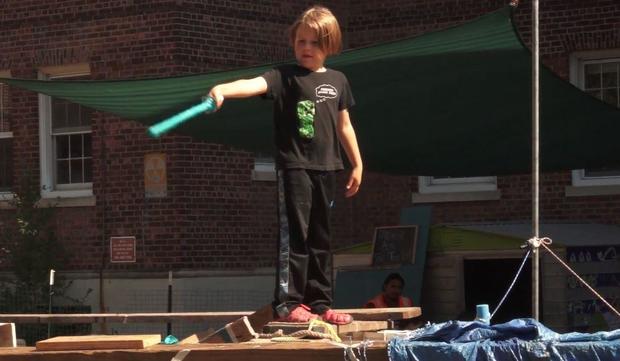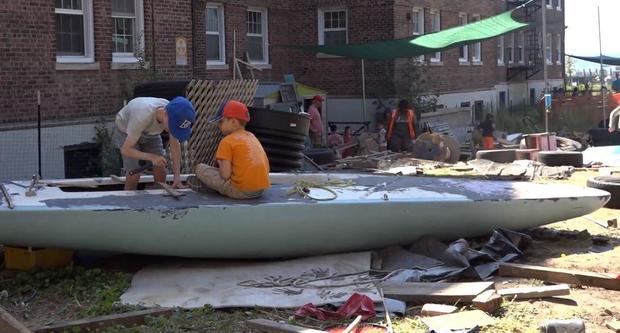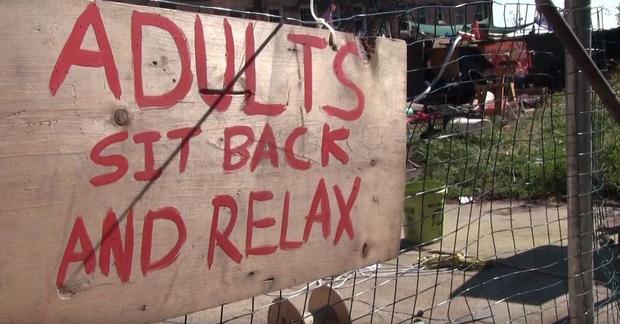Junkyard or playground paradise? Kids making their own adventures
NEW YORK With a nail in one hand and a hammer in the other, 7-year-old Zayne Cowie was hard at work building a home. He had already gathered planks of splintered wood, an old tire for the entrance and a tattered blue tarp for the roof. No parents were there to stop him as he started hammering away.
He wasn’t a homeless orphan, however, nor was he a victim of parental neglect. He was just one of dozens of kids running around New York City’s first adventure playground in decades.
This is a typical scene at play:groundNYC, located on Governors Island, where children are given a free space to play without any management, mediation or overprotection from parents. The nonprofit includes “playworkers,” the staff at an adventure playground that act like lifeguards, watching for dangerous hazards without interfering with activity.
“An adventure playground is a space that’s by and for children foremost,” said Eve Mosher, Zayne’s mother and a co-founder of play:groundNYC. “It’s about letting the kids walk really high up on the structure that they’ve built. ... It’s about creating space where they can take risks and experiment. In our specific case, it’s kind of like a junkyard for kids.”
Play is an important part of childhood development, both physical and psychological, researchers say.
“So much that’s positive in terms of intellectual development, social development, emotional development, physical development is best understood when understanding play,” said Roger Hart, professor of environmental psychology at The Graduate Center of the City University of New York.
Hart’s work focuses on child development and the quality of their physical environment. “Play is a great indicator of health. … It’s where children create their world and learn to know themselves.”
Sergio Pellis, professor of behavioral neuroscience at the University of Lethbridge in Alberta, Canada, has studied the effects of play in rats, finding that “if young rats are prevented from engaging with peers in social play, then when they get to young adulthood they show a variety of deficits in things like problems with impulse control, they are overactive to benign social stimuli, they have difficulty solving problems and encountering potentially dangerous situations.”
His research links those issues to changes in the prefrontal cortex of the brain, which can affect a wide-range of executive functions later in life, including attention span, emotional regulation and short-term memory.
Destructive and constructive play is a critical part in developing crucial motor and mental skills, Hart said. However, conventional playgrounds contain “fixed equipment” which leaves little to be built, created or destroyed by children.
Hart said conventional playgrounds are “useful, especially for very young kids, for gross motor play, as we call it, large muscle play. But, when it comes to children using the environment richly, they need to manipulate it, move things around, control it and feel that they’re directing their activity.”
This idea of self-directed, unmediated play is embodied in the idea of “adventure playgrounds,” or “junk playgrounds.” Unlike traditional playgrounds, these spaces leave kids with ample freedom, and the responsibility that comes with it.
In the process of building his structure, Zayne decided it was no regular home -- it was a castle. He began gathering tires for turrets and scrap wood for beams. As he jumped onto his new fortress, he lost his footing and fell to the dirt. He let out a cry, checked himself for cuts and stared up at the stronghold. A few minutes later, Zayne dusted himself off and climbed again, four or five feet in the air, and balanced carefully along the beams.
“They were able to try things out without huge consequences and self-directed play in particular hones skills and self-awareness,” said Alex Khost, an alternative educator and co-founder of playground:NYC.
Some parents, especially in cities, have looked for ways to give their children the opportunity for more self-directed play, a reaction against what some see as an increase in over-parenting.
“Children are often over-directed and taken from one activity to another and expected to be good at it, but at a place like this, they can let their imagination run free,” said Michael Haggiag, a NYC parent in support of playground:NYC. “I think it’s very important for children to have this time to confront whatever it is … to develop their imagination, to develop their sense of play without too much direction. I think that’s the source of all creativity.”
As their children use saws, nails, hammers, drills and other tools to build and destroy the contents of the playground, parents are relegated to the other side of a fence with signs that encourage them to “sit back and relax.”
“Initially, it does give you pause because it’s so rare that you let your kids go in an area where there’s sharp objects and wood stuff, but to see that they kind of police themselves in a way was reassuring,” said parent Tom Widmann during his first trip to playground:NYC. “Of all the kids that I’ve seen today, there doesn’t seem to be any incidents.”
Despite safety concerns, “in every study that I’ve found that has been done, adventure playgrounds have much lower levels of serious injury than your sort of traditional playgrounds,” said Reilly Wilson, graduate student for the Children’s Environments Research Group, focusing on adventure playgrounds. “Part of it is that regular playgrounds, as it were, are designed for safety and young people know that. So when young people play on a regular playground they often pay less attention to risks.”
Adventure or junk playgrounds were popularized in post-World War II Europe, where bombed-out ruins lingered for years. In the U.S., dozens were operating during the 1970s, though they’ve declined in popularity since.
Wilson and Hart said their decline in the U.S. was due to a number of factors, such as rising safety concerns, higher engagement with technology and a lack of funding. (In the adventure playground model, materials are low-cost but the playworkers are paid staff.)
Khost and Mosher were determined to bring one to NYC for the first time in decades. After months of searching for a site, they were offered a space by Governors Island, which they quickly accepted, and began building a world of creative junk. They filled the space with “loose parts” - acquired through donations, from their own homes or off the curb - that children could manipulate. They hired and trained playworkers to watch over the environment and implemented a strict “no parent” rule.
Playworkers are a critical part of any adventure playground. Their role is not only to provide a watchful yet unintrusive eye but also play a unique role in a child’s life. “They’re no longer an instructor, they’re somebody who seems to respect you as an equal, as a citizen and so the kids start to talk with these people. That is really wonderful. … It’s an organic type of social work,” said Hart.
As Janea Singleton, a playworker at play:groundNYC, helped Zayne clamp in a piece of wood, he grabbed a hand saw and they chatted about lunch and the day ahead. Earlier, she helped a group of children learn how to use a hacksaw, calmly answering questions, grabbing tools from the toolshed and encouraging kids to make use of anything around them. Singleton said the hardest part of being a playworker is learning not to say “no,” but instead “stepping back and letting them surprise you.”
Play:groundNYC opened its permanent site on Governors Island this summer and soon found it attracting 80 to 100 children a weekend. The suggested age to play on the main junk playground is 6 years and older; kids 3 years and up can head to the “family” playground, where parents are allowed on the grounds. Parents must sign a liability waiver and the site is insured. The space is free to the public on weekends as weather permits and the summer camp was filled to capacity. With nearly half a year down, the creators are now looking for creative ways to keep children engaged in the short term while still thinking about longer term goals.
“Our dream is that it goes out and we can be a model for other people to start adventure playgrounds in their communities and it’s a place where kids can go there after school and play,” Mosher said. “That’s the dream.”



